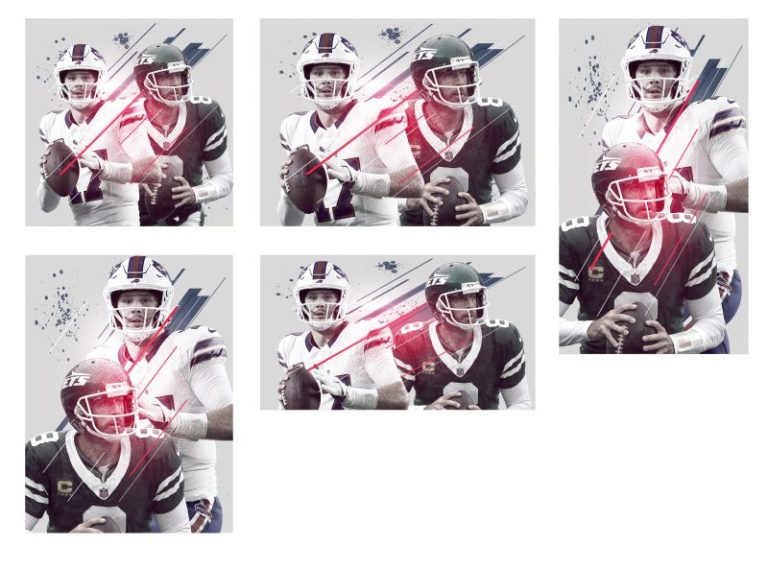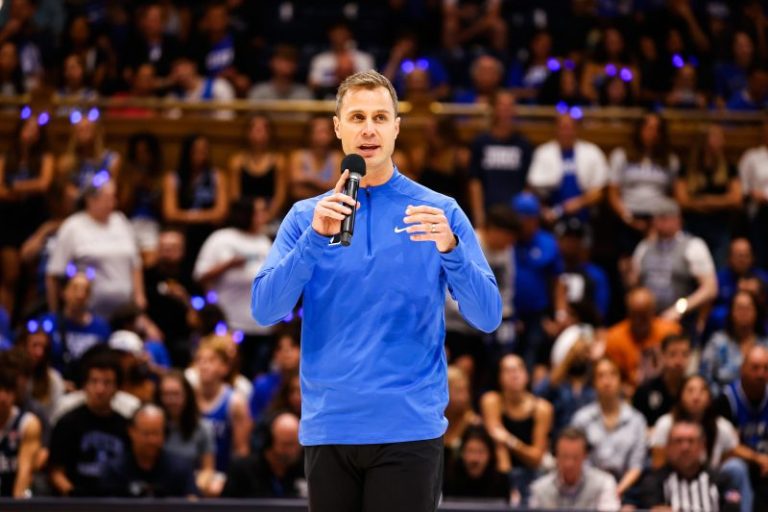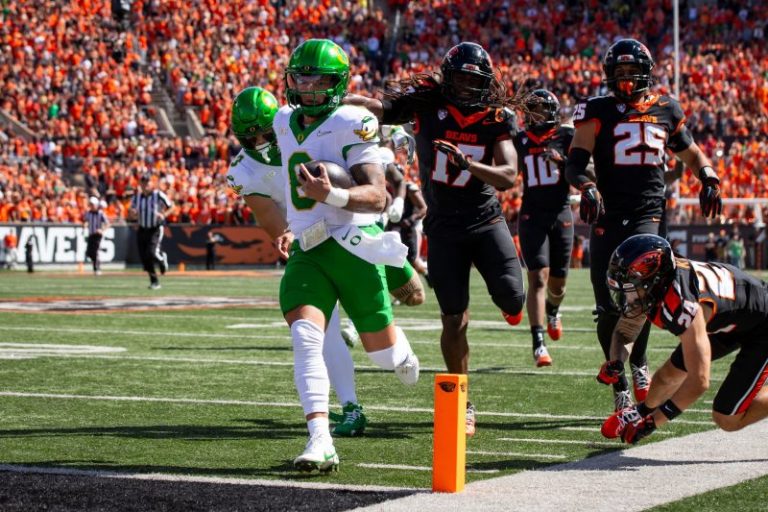Offseason gambles have paid off in a big way for No. 2 Ohio State and No. 3 Oregon, who meet on Saturday in a Big Ten clash pitting two of the best teams and best offenses in the Bowl Subdivision.
Both teams exited last season looking for a new starting quarterback. Current Syracuse quarterback Kyle McCord left Ohio State last December after getting a tepid vote of confidence from coach Ryan Day on the heels of another loss to Michigan. After two seasons of record-setting production, former Oregon starter Bo Nix was taken in the first round of this year’s NFL draft.
Instead of looking within the program, however, the two went shopping for a new starter in the transfer portal. Ohio State landed on Kansas State transfer Will Howard. The Ducks signed former Central Florida and Oklahoma transfer Dillon Gabriel. These two newcomers have stepped seamlessly into the starting lineup and steered the Buckeyes and Ducks on a collision course for the College Football Playoff.
‘When you come to a place like Ohio State, you want to play on a big stage. This is what you sign up for,’ Howard said. ‘This is what college football is all about. This is what you dream about as a kid.’
A similar scene continues to play out every winter across the FBS. The adoption of the transfer portal and the frenzied chase for payouts related to name, image and likeness have turned quarterback recruiting and retention into an annual game of musical chairs capable of boosting or bursting any hopes of reaching the College Football Playoff.
Since the 2021 season, when NIL and the portal went into effect across college sports, there have been 77 different quarterbacks who have transferred into a Power Four program and been the primary starter for at least one season.
The number of such quarterbacks has grown every year, reaching unprecedented heights in 2024. This season, there are 41 transfers starting in the Power Four, including at all but four schools in the Big Ten. In comparison, there were only nine such starters in the Power Four in 2021.
“My first day on the job we had 10 offensive starters in the transfer portal, one guy being our quarterback or the guy who had played quarterback here last year,” said first-year Indiana coach Curt Cignetti. “You’re in a whole new ballgame.”
HARD TRUTH: Win-now world of college football makes transfer QBs king
HARD TRUTH: You need a quarterback if you want best chance for title
Evaluating the transfer quarterback success rate
To assess the success rate of these quarterbacks, USA TODAY Sports evaluated Power Four transfers during the portal and NIL era across two categories. The first is individual success, such as touchdowns, turnovers, yards, performance against Top 25 competition and end-of-year accolades. The second is team success, judged primarily by wins and losses, postseason record and whether the team showed notable improvement or decline in production at the position.
The jury remains out on 15 transfers starting in the Power Four this season. Using our metrics, 34 of the 62 remaining transfers, or roughly 55%, can be seen as a success, leaving 28 who fell short of expectations.
The successes include the past two Heisman Trophy winners in Caleb Williams and Jayden Daniels, as well as current Heisman favorites in Cam Ward, Jaxson Dart and Quinn Ewers.
An analysis of these quarterbacks centered on which transfers were successful and why revealed the three questions that can help coaches and programs avoid a recruiting misfire at this key position:
Does the quarterback have starting experience, and is that experience coming from a Power Four conference or from the Group of Five and Championship Subdivision?
Is the quarterback an upperclassman transferring as a graduate student, or is he transferring with multiple seasons of eligibility?
Do members of the coaching staff or program have any built-in familiarity with the player, whether through contact as a high school recruit, by playing against the quarterback or by directly coaching him at a previous stop?
Why starting experience matters
Whether the transfer brings starting experience to his new program could be the strongest predictor of eventual success or failure.
There are 17 transfers during this era who entered the portal with less than one full season of prior starting experience. Of that group, 10 fell short of expectations, including former Colorado quarterback J.T. Shrout, former Virginia Tech quarterback Braxton Burmeister and current Purdue quarterback Hudson Card.
But the seven who beat the odds count among the most productive quarterbacks in recent FBS history. This group includes Dart and Ewers — Dart made three starts as a true freshman at Southern California in 2021 — along with former Kentucky quarterback Will Levis and current Utah quarterback Cam Rising.
In total, 27 of 34 transfers who met our metrics for success had started at least one full season before entering the portal.
“There are a lot of really great players that were in the portal last year at quarterback, but we believed that he was the best one,” Syracuse quarterbacks coach Nunzio Campanile said of McCord. “We thought that if we could get him here, because of that experience, the makeup and the talent, all those things, we thought he could have a huge impact.”
While this trend points to a connection between starting experience and success with a new program, there are examples that point to the unpredictability that comes with acquiring a transfer quarterback.
The clearest illustration of this randomness can be seen in the case of former Clemson quarterback DJ Uiagalelei, who improved dramatically last season at Oregon State but was the poster child for Florida State’s current struggles before suffering a potentially season-ending hand injury during in the team’s loss to SMU last month.
The importance of starting experience is supported by the success rates of players from the Group of Five or lower levels of competition compared to those from the Power Four.
Nine of the 12 Group of Five or FCS transfers during this era hit the mark, including current starters in Colorado’s Shedeur Sanders, Vanderbilt’s Diego Pavia and Indiana’s Kurtis Rourke. Of this group, only two did not have a full season of starting experience when entering the portal: current Boston College quarterback Thomas Castellanos and former Central Florida quarterback John Rhys Plumlee.
“He’s like an NFL veteran playing quarterback,” Cignetti said of Rourke. “He’s poise under pressure, man. That guy is cool as a cucumber.
“I’ve been around the game all my life. And there are guys that can play and are not necessarily playing in the (Power Four) right now.”
The downside of one-year rentals
Analyzing quarterbacks during this stretch reveals the pitfalls associated with one-year rentals. This subset of transfers represented the standard before the NCAA allowed all players to switch schools without being penalized a season of eligibility.
Twenty-six transfers since 2021 fall into this category. Of this group, only 11, or about 43%, meet the standard for success. Six of those quarterbacks transferred this past offseason: Howard, Gabriel, Ward, McCord, Pavia and Rourke. The 15 ineffective senior-year additions account for more than half of the 28 overall transfers who failed to meet expectations.
Conversely, 23 of the 34 successful quarterbacks transferred with at least two years of remaining eligibility. Eleven transferred as redshirt freshmen or sophomores.
At a time when it’s becoming increasingly difficult for coaches to turn a high school recruit into a starter — more and more Power Four quarterbacks are entering the portal after losing one offseason competition for the starting job — programs able to sign a transfer as an underclassman are given a longer runway for development.
Overall, 18 of the 25 transfers who have gone to start multiple years with their new programs meet the standard for being seen as a successful addition.
The benefit of an existing relationship
While difficult to measure, there is ample anecdotal evidence suggesting coaches give themselves the best chance for success by recruiting transfers with whom they have some level of prior acquaintance or awareness — often as recruits coming out of high school but in some instances by coaching the player at his previous stop.
‘We’re looking for the talent threshold that has to be there,’ Kentucky coach Mark Stoops said. ‘But I also think the intangible qualities that we’re looking for that fit our team, our culture, that we feel like that player can come in at that position and win over the team and be a leader.’
Kentucky has played with a transfer quarterback as its primary starter for the past nine seasons, including this year with Brock Vandagriff from Georgia. The Wildcats have had various levels of success in that span with Terry Wilson and Will Levis each leading teams to 10-win seasons and Devin Leary from North Carolina State having a disappointing campaign in 2023 .
In these cases, programs can feel comfortable with the new quarterback’s ability to handle the demands of the starting role or, better yet, the quarterback could have a level of experience in the offensive system that erases the need for any immediate learning curve.
Caleb Williams followed Southern California coach Lincoln Riley from Oklahoma. Gabriel’s offensive coordinator with the Sooners, Jeff Lebby, was his coordinator as a freshman at Central Florida. Ewers had been verbally committed to Texas before signing with Ohio State; he transferred to the Longhorns after his freshman season.
Vanderbilt coach Clark Lea added not just Pavia from New Mexico State this past season but also a slew of former New Mexico State assistants, including offensive coordinator Tim Beck. Former NMSU head coach Jerry Kill was hired as the Commodores’ chief consultant to the head coach and senior offensive advisor.
Multiple Syracuse coaches had previously recruited McCord, the Pennsylvania Gatorade Player of the Year as a senior at St. Joseph’s Preparatory School in Philadelphia. Several factors made McCord one of the jewels of last year’s transfer cycle, including his extensive experience as the starter in a high-pressure situation at Ohio State.
But while no assistant had overlapped with the Buckeyes during McCord’s time with the program, these existing relationships simplified the decision to make him Syracuse’s must-have transfer target. That the Orange knew what they were getting helped to remove a chunk of the guesswork from the equation.
“We knew that character-wise and work ethic-wise, he was going to be a great fit,” said Campanile. “On top of that, we had watched him develop through high school and then were able to see everything that he did at Ohio State. So I think that he had a history of performance that you’re like, ‘OK, we know he’s going to be a really good player.’ But more importantly, we knew that he was a really good person and a great fit for what we were looking for.”
This post appeared first on USA TODAY










